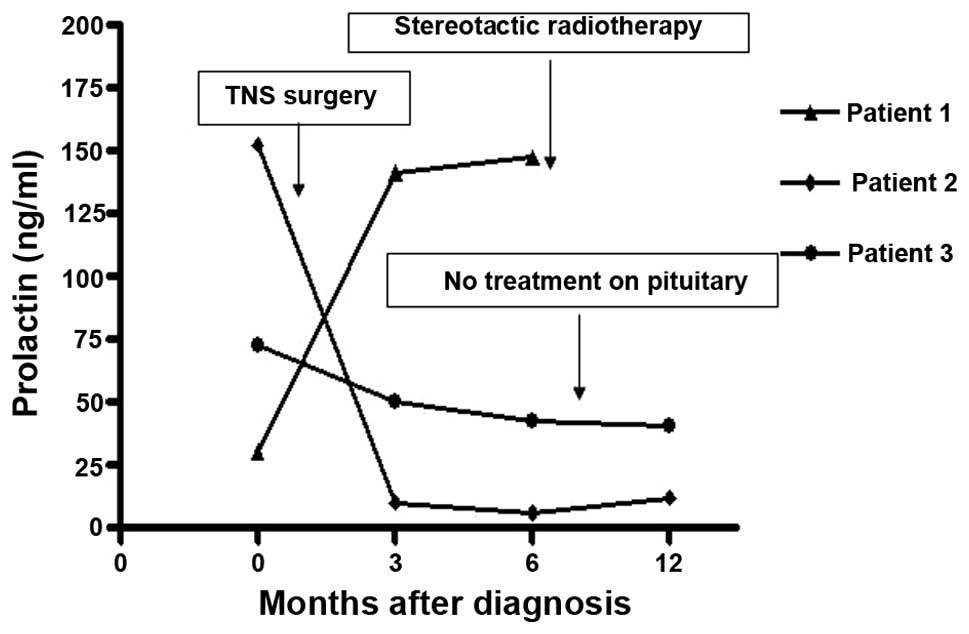Pituitary lesions in breast cancer patients: A report of three cases
- Authors:
- Nicoletta Fortunati
- Francesco Felicetti
- Michela Donadio
- Emidio Grossi
- Federica Michelon
- Giuliana Ritorto
- Emanuela Arvat
- Enrico Brignardello
View Affiliations
Affiliations: Transition Unit for Childhood Cancer Survivors, Department of Oncology, Città della Salute e della Scienza di Torino, Turin 10126, Italy, Breast Unit, Department of Oncology, Città della Salute e della Scienza di Torino, Turin 10126, Italy, Oncological Endocrinology Unit, Department of Oncology, Città della Salute e della Scienza di Torino, Turin 10126, Italy
- Published online on: April 24, 2015 https://doi.org/10.3892/ol.2015.3149
-
Pages:
2762-2766
Metrics: Total
Views: 0 (Spandidos Publications: | PMC Statistics: )
Metrics: Total PDF Downloads: 0 (Spandidos Publications: | PMC Statistics: )
This article is mentioned in:
Abstract
Pituitary metastases occur in 6-8% of breast cancer cases, but are seldom diagnosed and rarely reported. Therefore, it can be challenging to establish a clinical differential diagnosis, and at present, a definitive criteria is not available. The present study discusses the pituitary lesions identified in three patients with breast cancer, and describes their management within the collaborative framework of the Breast Unit at the Città della Salute Hospital, which also included assessment by endocrinologists. The patients were evaluated for anterior and posterior pituitary function, the appearance of the pituitary upon magnetic resonance imaging (MRI), and the oncology status and treatment. In addition, successive analysis of prolactin levels and the MRI was performed. The patients, aged 75, 83 and 76 years old, differed in their clinical presentation and successive evolution. One patient demonstrated an abrupt onset of diabetes insipidus, the second exhibited overt hypopituitarism and the final patient had a pituitary mass discovered by chance. Cases one and three exhibited systemic spread of the breast cancer, with bone and/or parenchymal metastasis, but not brain metastasis. Case two presented with a secondary pituitary tumour alone. In case three, a secondary nature to the pituitary lesion was unlikely, since there was no lesion evolution evident following MRI and as stable prolactin levels were observed over the course of the study period. By contrast, case one presented with a rapid increase of sellar lesions on MRI, together with a progressive rise in prolactin levels. Taking into account the frailty of breast cancer patients who are monitored for disease progression, management in a collaborative framework, such as at the Breast Unit, makes it possible to establish a diagnosis of sellar lesions, which is adequate for the comprehensive management of the patient with successive pituitary MRIs and prolactin evaluations, and avoids unnecessary invasive neurosurgery.
View References
|
1
|
Gupta GP and Massagué J: Cancer
metastasis: building a framework. Cell. 127:679–695. 2006.
View Article : Google Scholar : PubMed/NCBI
|
|
2
|
Nguyen DX, Bos PD and Massagué J:
Metastasis: from dissemination to organ-specific colonization. Nat
Rev Cancer. 9:274–284. 2009. View
Article : Google Scholar : PubMed/NCBI
|
|
3
|
Sioutos P, Yen V and Arbit E: Pituitary
gland metastases. Ann Surg Oncol. 3:94–99. 1996. View Article : Google Scholar : PubMed/NCBI
|
|
4
|
Fassett DR and Couldwell WT: Metastases to
the pituitary gland. Neurosurg Focus. 16:E82004. View Article : Google Scholar : PubMed/NCBI
|
|
5
|
Zoli M, Mazzatenta D, Faustini-Fustini M,
Pasquini E and Frank G: Pituitary metastases: role of surgery.
World Neurosurg. 79:327–330. 2013. View Article : Google Scholar : PubMed/NCBI
|
|
6
|
Marsh JC, Garg S, Wendt JA, Gielda BT,
Turian JV and Herskovic AM: Intracranial metastatic disease rarely
involves the pituitary: retrospective analysis of 935 metastases in
155 patients and review of the literature. Pituitary. 13:260–265.
2010. View Article : Google Scholar : PubMed/NCBI
|
|
7
|
Komninos J, Vlassopoulou V, Protopapa D,
Korfias S, Kontogeorgos G, Sakas DE and Thalassinos NC: Tumors
metastatic to the pituitary gland: case report and literature
review. J Clin Endocrinol Metab. 89:574–80. 2004. View Article : Google Scholar : PubMed/NCBI
|
|
8
|
Benjamin L: Ein Krebsfall. Virchows Arch
Path Anat. 12:566–569. 1857. View Article : Google Scholar
|
|
9
|
Chiang MF, Brock M and Patt S: Pituitary
metastasis. Neurochirurgia (Stuttg). 33:127–131. 1990.PubMed/NCBI
|
|
10
|
Freda PU and Post KD: Differential
diagnosis of sellar masses. Endocrinol Metab Clin North Am.
28:81–117. 1999. View Article : Google Scholar : PubMed/NCBI
|
|
11
|
Shubinger O and Haller D: Metastases to
the pituitary - hypothalamic axis. An MR study of 7 symptomatic
patients. Neuroradiology. 34:131–134. 1992. View Article : Google Scholar : PubMed/NCBI
|
|
12
|
Leramo OB, Booth JD, Zinman B, Bergeron C,
Sima AA and Morley TP: Hyperprolactinemia, hypopituitarism, and
chiasmal compression due to carcinoma metastatic to the pituitary.
Neurosurgery. 8:477–480. 1981. View Article : Google Scholar : PubMed/NCBI
|
|
13
|
Post KD: Pituitary metastases: what is the
role of surgery? World Neurosurg. 79:251–252. 2013. View Article : Google Scholar : PubMed/NCBI
|
|
14
|
Turaka A, Parsons RB and Buyyounouski MK:
Radiation therapy for pituitary metastasis: report of four cases.
Tumori. 98:e1–e6. 2012.PubMed/NCBI
|
|
15
|
Vlotides G, Eigler T and Melmed S:
Pituitary tumor-transforming gene: physiology and implications for
tumorigenesis. Endocr Rev. 28:165–186. 2007. View Article : Google Scholar : PubMed/NCBI
|











